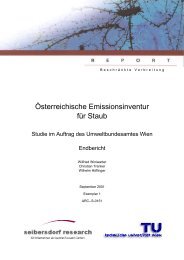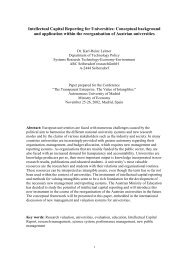ALPMON FINAL REPORT - ARC systems research
ALPMON FINAL REPORT - ARC systems research
ALPMON FINAL REPORT - ARC systems research
Create successful ePaper yourself
Turn your PDF publications into a flip-book with our unique Google optimized e-Paper software.
Contract ENV4-CT96-0359 <strong>ALPMON</strong><br />
land use classes as resulted from the investigations of the LfW in the hilly environment of the Vils test<br />
site (Molnár & Casper, 1998).<br />
Sulm test site<br />
In the Sulm test site, main emphasis was put on the preparation and implementation of additional<br />
information, such as meteorological parameters and soil maps, as well as the performance of ASGI for<br />
a selected time period. The Section of Water Resources of the Austrian Province of Styria was<br />
interested in testing whether the ASGI water run-off model is appropriate for integration into the flood<br />
information service of Styria. An important additional prerequisite of this customer was, that the model<br />
requires only data which are already available for the whole province of Styria, or data which can be<br />
acquired with limited financial and time effort for the whole country (total area of Styria: 16.400 km 2 ).<br />
The result of the Sulm test site study is a complete demonstration of the ASGI water run off model<br />
including a comparison of modelled and measured water run off.<br />
2.3.2.3 Implementation of Remote Sensing into the Model<br />
The programming system ASGI consists of the 4 main modules<br />
� Data management (Datenmanagement)<br />
� Data preparation (Präprozessor)<br />
� Data processing (Prozessor)<br />
� Data presentation (Postprozessor).<br />
The module "Data Management" includes<br />
� the project- and variant specific database management<br />
� the fast input of external data (including data check) and<br />
� the optional data storage and restoration.<br />
This module offers the interface to <strong>ALPMON</strong> caused by the need for grid-based data. The Bavarian<br />
State Office for Water Resources has the opinion, that the requirements can only be satisfied by using<br />
remote sensing data.<br />
The implementation of remote sensing into the model is provided for the present land use / land cover<br />
information. Looking forward to the high resolution satellite data of the future and the resulting need on<br />
high precision DEM for pre-processing this data, DEM generation from stereo satellite image data is a<br />
second link between ASGI (or more general, water run off models) and remote sensing.<br />
2.3.2.4 Run-off Modelling with ASGI (Sulm Test Site)<br />
The methods described below were selected based on the user requirements and the data layers<br />
needed for the water run-off model. In ASGI a so called ‘pre-processor’ module is used for the<br />
preparation of the spatial and temporal data. This comprises in a first step the conversion of the<br />
various data layers into the formats required by the model.<br />
The structure of ASGI is modular (based on the methods of the WASIM-ETH model), and often several<br />
calculation methods are offered to the user. In the project performed for the Section of Water<br />
Resources of the province Styria following approaches have been used:<br />
� Interpolation of meteorological input data by application of Inverse Distance Weighting Interpolation<br />
(IDW);<br />
� Calculation of potential evaporation after Hamon (Federer & Lash, 1983)<br />
� Estimation of the interception storage capacity dependent on leaf area index and degree of<br />
vegetation coverage, based on the landcover classification results<br />
� Infiltration model after Peschke (1987), based on Green and Ampt (1911)<br />
� Soil model: saturated area approach using the topographic index after Beven and Kirkby (1979).<br />
� Runoff separation into surface runoff, interflow, and baseflow<br />
� Routing of surface runoff by subdivision of the basin into flow time zones combined with a single<br />
linear storage routing.<br />
2.3.2.5 Results from Mangfall Test Site<br />
The results of the investigations delivered to the customer LfW are of two categories:<br />
JR, RSDE, ALU, LMU, Seibersdorf, WSL 33




